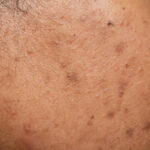It is often observed that women with rich complexion tend not to age as visibly and as quickly as those of European descent do. However, it has been established that invasive anti-aging procedures are mostly optional, brown skinned women often times turn to anti-aging ointments, muscle relaxants and filler substances. Furthermore, a lot of brown skinned women put their faith in other minor procedures that helps to curtail aging manifestations and to augment the look of their skin and salvage it from conditions like acne and pseudofolliculitis barbae (razor bumps).
Minor procedures are categorised as non-surgical. This include chemical peels and microdermabrasion. These procedures however are markedly simple and safe, knowing enough about these procedures would be a prudent move before going for any. Besides these tips, your dermatologist should be consulted to ensure these are the appropriate treatments for your skin. In conclusion, being a brown skinned woman-whatever procedure you choose to go for, ensure it is carried out by a certified health care professional only with experience in brown skincare.
Chemical Peels
Chemical peels involve a practice where a chemical solution is brought in direct contact with your naked skin. In cases of women with brown skin, peels are often applied in a range of situations. They are employed when the aim is to brighten up dark patches or blemishes, to achieve a uniform skin tone, smoothen rough-textured skin types, alleviate wrinkles, reasonably even out acne and razor bumps, shed plugged pores, tighten up enlarged pores, and even out depressed scars. These chemical procedures are often carried out on the face, but can also be done on other body areas that may be indicated for such.
The mechanism employed by chemical peels is the removal of the mutilated or aged uppermost layers of the skin. These procedures peel off the outer layers of the skin called the ‘stratum corneum’ or uppermost epidermis in layman terms. They are also involved in the stimulation of collagen production in the dermal layer of the skin. The extent of peel is dependent on the chemical used, duration of contact with skin, and the amount of chemical applied.
A vast array of superficial chemical peeling agents are safe for rich complexion use. They come in numerous varieties, including Fruit acid peels, lactic acid peels, alphahydroxy acid peels (glycolic acid), betahydroxyacid peels (salicylic acid), and 15% to 20% trichloroacetic acid peels (TCA). This list of peels is often very mild and may be used in varying concentrations which could be weekly or at better-spaced intervals to get an optimal result. A string of 4-6 peels is advised for best results.
More invasive chemical peeling agents (deeper peels) include: Obagi Blue peel, 35% trichloroacetic acid peel, and the Phenol peel can be more intensive and so should be used with extreme caution on brown skin. These peels characteristically require about 2-weeks of healing time, they slough off the epidermal layer and thereby renders the skin absolutely eroded. On some occasions, the skin may heal with an abnormal pigmentation-a darker patch that is visibly different from your normal skin tone.

On consultation with your dermatologist, they will weigh possible offshoots and choose the appropriate solution that would be best for your skin. It is essential that your preferred procedure is carried out by a certified dermatologist. Certain states however may demand no medical degree to carry out a chemical peel. Nonetheless, having highlighted the possible risks involved in this procedure, it is very essential that you still go with a certified specialist.
Most chemical peels do not require a surgical theatre as they are often safely performed in your dermatologist’s office. It is regarded as a markedly painless procedure, it lasts for about 10-15 minutes and the use of an anesthetic agent is not needed. This procedure often involves a gentle cleansing of your face and dried subsequently. The selected solution is applied with a cotton pad, sponge, cotton swab, or brush at times. Any of the aforementioned is used on areas marked out for treatment (if the entire face is to be treated though, the eyes, brows, and lips must be avoided). A burning, stinging or itching sensation may be felt as the procedure is being done. To reduce discomfort induced by these sensations, cooling may be employed by the use of a fan or the use of cold compresses. In about 10-minutes when the procedure is being wrapped up, a neutralizing solution or water may be used on your skin followed by further cleansing. Your doctor may suggest the use of an “after-peel” cream or ointment. The use of sunscreen is very essential after the peel as your skin will be more susceptible to sunburns. The wearing of make-up is not outrightly prohibited but do well to consult your doctor on the appropriate time to do so and also the best kind for your skin.
Oftentimes, a number of over-the-counter or prescribed products may have been recommended by your dermatologist alongside your peels. These would come back into play a few days post-procedure. Alphahydroxyacid-containing cleansers or topical fruits acid creams and lotions when applied daily may augment the journey to achieving a smoother and brighter skin void of dark marks or blemishes. Cream that contains retinoid and antioxidants with your frequently prescribed acne or razor bump medications may also stir you towards the desired eventuality faster.
Side effects are seldomly an issue with most superficial peels however, a few women report minor cases to include: dark patches, irritation, flaking, crusting, redness, scabbing or temporary dryness. A few deeper peels may also ignite marked swelling and pose the risk of scarring, possible infection, and eventual abnormal pigmentation. It is possible to notice an increased sensitivity to the sun following a chemical peel. In all, strict adherence to your doctor’s pre-peel and post-peel instructions should be adequate in curbing the risks of these offshoots.
Effects of sun exposure and the use of sunscreens.
Chemical Peels make your skin more sensitive to sunlight, so it’s prudent to use a gentle and effective sunscreen that will not irritate your delicate post-peel skin and help you maintain the best results from your treatment. Wearing sunscreen is a must all the time year-round, but especially when you’ve just had a chemical peel



